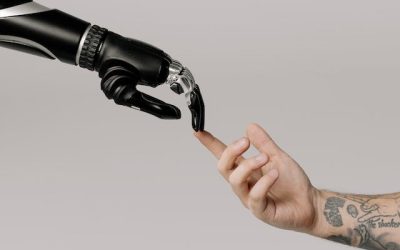Generative AI is a rapidly growing field that has the potential to revolutionize the way we create, imagine, and interact with technology. At its core, generative AI is a type of artificial intelligence that has the ability to create new, original content that is indistinguishable from human-created content. This article aims to provide a comprehensive explanation of generative AI, its underlying principles, and its applications across various industries. Additionally, this article will highlight the differences between generative AI and other AI techniques, as well as the potential impact that generative AI may have on society and the economy.
Underlying Principles of Generative AI:
The underlying principles of generative AI involve the use of machine learning algorithms to learn and generate new content. Most commonly, generative adversarial networks (GANs) and variational autoencoders (VAEs) are used in generative AI applications.
Generative Adversarial Networks:
A generative adversarial network, or GAN, is a type of deep learning algorithm that is composed of two neural networks: a generator and a discriminator. The generator creates new content, while the discriminator evaluates the content to determine if it is real or generated.
During training, the generator creates new content that is then evaluated by the discriminator. If the discriminator determines that the content is not real, it provides feedback to the generator, which uses this feedback to adjust its approach and create new content. This process continues until the generator is able to consistently create content that is indistinguishable from human-created content.
Variational Autoencoders:
A variational autoencoder, or VAE, is another type of deep learning algorithm that is used in generative AI applications. VAEs are neural networks that are trained to create a compressed version of input data.
During training, the VAE learns the underlying structure of the input data and creates a compressed version that is used to generate new, similar data. VAEs are commonly used to generate new images or videos that are similar to input data provided during training.
Applications of Generative AI:
Generative AI has many potential applications across various industries, including:
Art and Design:
Generative AI can be used to create new art pieces or designs that are unique and original. For example, GANs have been used to create new fashion designs for clothing companies.
Advertising:
Generative AI can be used to generate new advertising content, such as images and videos. For example, GANs have been used to create new ad designs for Nike’s “Jordan” brand.
Virtual Assistants:
Generative AI can be used to develop virtual assistants, chatbots or conversational agents who can provide assistance on a variety of topics.
Game Development:
Generative AI can be used to create new and unique game designs. For example, GANs have been used to create new character designs for video games.
Healthcare:
Generative AI has the potential to improve medical imaging and diagnosis through the creation of new imaging tools and algorithms. For example, VAEs have been used to create new algorithms for disease detection and analysis.
Differences between Generative AI and Other AI Techniques:
The main difference between generative AI and other AI techniques is that generative AI focuses on the creation of new content, whereas other AI techniques focus on recognizing and understanding existing content. For example, supervised learning techniques are used to classify images or texts based on existing categories, while unsupervised learning techniques are used to find patterns in unstructured data.
Potential Impact of Generative AI:
Generative AI has the potential to greatly impact society and the economy in a variety of ways. Some potential benefits of generative AI include:
- Improved Creativity:
Generative AI can be used to inspire new ideas or designs, providing creatives with new tools and resources to create unique content. - Increased Productivity:
Generative AI can be used to automate the creation of new content, freeing up time for humans to focus on more complex or creative tasks. - Improved Healthcare:
Generative AI has the potential to improve medical imaging and diagnosis, leading to better patient outcomes.
However, generative AI also poses risks, such as the creation of fake news or disinformation. The use of generative AI in creating deepfakes, which are manipulated videos or images that can deceive people, has raised concerns about the impact of this technology on society.
In order to mitigate the risks associated with generative AI, researchers and practitioners must carefully consider the potential consequences of their work and take steps to ensure that the technology is not used to deceive or mislead people.
One possible solution to this problem is the development of new algorithms and techniques that can detect and identify fake images or videos created using generative AI. For example, researchers at MIT have developed an algorithm that can detect deepfakes with a high degree of accuracy by analyzing subtle differences in the way that fake and real images are created.
Another possible solution to the problem of fake content is the development of new standards and regulations for the use of generative AI in advertising, journalism, and other industries. The creation of codes of ethics or best practices for generative AI could help to ensure that the technology is used responsibly and in a way that benefits society as a whole.
In conclusion, generative AI is a powerful technology that has the potential to transform industries and create new opportunities for innovation and creativity. However, the risks associated with this technology must be carefully managed through the use of new algorithms, standards, and regulations to ensure that it is used responsibly and in a way that benefits society as a whole. By working together to address these challenges, we can unlock the full potential of generative AI and create a brighter future for all.
——————-
Generative AI coding structure encompasses several components that must interact with one another in order to produce desired outputs. In this article, we will take a deep dive into the coding structure for generative AI, including details on programming languages commonly used, algorithms and techniques employed, and overall architecture. We will also discuss how these components are optimized for performance, as well as best practices and common pitfalls in coding for generative AI.
Programming Languages for Generative AI
There are several programming languages commonly used for generative AI, including Python, C++, and Java. Of these, Python is the most popular due to its ease of use, flexibility, and large number of available libraries and frameworks.
With Python, developers can take advantage of several popular machine learning frameworks, such as TensorFlow, PyTorch, and Keras, which provide tools for building and training deep neural networks. Python also has a large and active community of developers who contribute to open-source libraries and provide support for common issues.
Algorithms and Techniques Employed in Generative AI
Generative AI is based on the principles of statistical analysis and probabilistic modeling. It uses algorithms and techniques such as deep learning, variational autoencoders, and generative adversarial networks to generate new content.
Deep learning involves the use of neural networks to recognize patterns in large datasets and make predictions based on those patterns. Variational autoencoders are a type of neural network that is used for unsupervised learning, while generative adversarial networks involve the use of two neural networks, one of which generates new content and the other of which evaluates the realism of that content.
Architecture of Generative AI Systems
Generative AI systems are typically composed of several layers of neural networks, each of which is responsible for different aspects of the generative process. The input layer of the network takes in data, such as images or text, that will be used to generate new content.
The middle layers of the network analyze the input data and generate predictions based on that data. These predictions are then used to generate new content, which is output by the final layer of the network.
The overall architecture of a generative AI system can vary depending on the specific application, but it generally involves the use of several interconnected neural networks that work together to generate new content.
Optimizing Performance in Generative AI Systems
Optimizing performance in generative AI systems involves several key strategies, such as selecting a suitable programming language, utilizing highly optimized algorithms and techniques, and leveraging hardware acceleration when possible.
To achieve optimal performance, developers must also carefully manage the size of their dataset and the complexity of their neural networks. This is because larger datasets and more complex networks can require significant computational resources, which can impact performance.
Best Practices and Common Pitfalls
One of the most important best practices in coding for generative AI is to start with a clear problem definition and well-defined goals. This will allow developers to design a system that is tailored to specific needs. Additionally, it is important to carefully select datasets for training in order to ensure that the generative AI system produces high-quality outputs.
Another best practice is to perform regular testing and validation of the generative AI system to ensure that it is producing desired results. This includes testing the system on a variety of inputs and evaluating its output against established criteria.
One common pitfall in coding for generative AI is overfitting. Overfitting occurs when a neural network is trained on a small or biased dataset, causing it to become too specialized in generating content that is based solely on that dataset. This can lead to a lack of diversity in the generated content, which can limit its usefulness.
To avoid overfitting, it is important to use large and diverse datasets that are representative of the problem being solved. Additionally, regularization techniques such as dropout can be used to reduce overfitting.
Another common pitfall is the failure to optimize the system for performance. This can lead to slow computation times and an inability to generate content on a large scale. To optimize for performance, developers must carefully select programming languages and hardware, and design their systems with speed and scalability in mind.
Conclusion
The coding structure for generative AI involves several components that must interact with one another in order to produce desired outputs. Programming languages commonly used for generative AI include Python, C++, and Java. Generative AI systems are based on the principles of statistical analysis and probabilistic modeling, and employ algorithms such as deep learning and generative adversarial networks. The architecture of a generative AI system generally involves several layers of interconnected neural networks.
To optimize performance and avoid common pitfalls in coding for generative AI, it is important to use large and diverse datasets, perform regular testing and validation, avoid overfitting, and optimize for performance. With these strategies in mind, developers can create high-quality generative AI systems that have the potential to revolutionize many industries.
Conclusion:
Generative AI is a rapidly growing field that has the potential to revolutionize the way we create, imagine, and interact with technology. Through the use of machine learning algorithms such as GANs and VAEs, generative AI can create new, original content that is indistinguishable from human-created content. This technology has many potential applications across a variety of industries, including art and design, advertising, game development, healthcare, and virtual assistants. While generative AI has many benefits, it also poses risks that must be carefully managed to minimize the potentially negative impact on society and the economy.



0 Comments